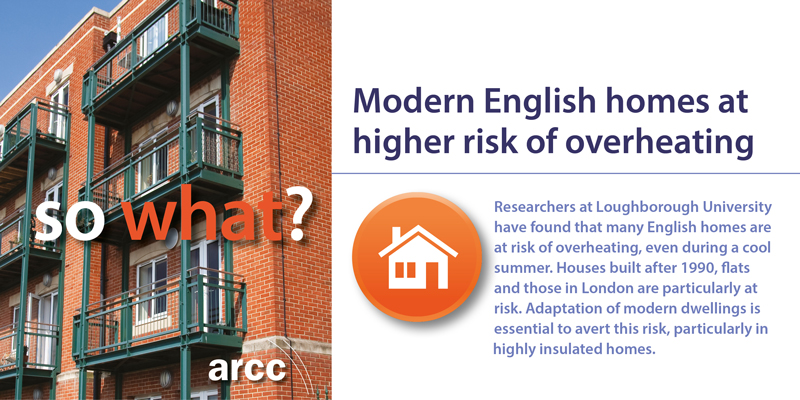Researchers at Loughborough University have found that a large proportion of English homes are at risk of overheating even during a cool summer. Houses built after 1990, flats and those in London are particularly at risk.
Living room and bedroom temperatures were recorded in 207 homes across England during the summer of 2007. The results are striking as, despite the cool summer, 27% of living rooms and 47% of bedrooms were above the recommended temperature thresholds of 25°C and 24°C respectively for more than 5% of their occupied hours. The incidence of warm bedrooms is even more significant when examining only the post-1990 dwellings and flats, where 80% of houses and 74% of flats exceeded the criteria.
Relevance
The UK climate has been warming, with the central England annual average temperature increasing by about 1 °C over the last century. This trend is expected to continue, resulting in an increase in the annual average temperatures across the UK of 2–3.5 °C by 2080.
The impacts of high summertime temperatures in UK dwellings were felt during the last decade’s hot weather events. The European heatwave of August 2003 resulted in over 2000 (16%) additional deaths in England and Wales, with the highest impact in London and on the elderly.
Nationwide measurements and surveys of dwellings enable and understanding of the impact of location, building type, age and wall construction on summertime temperatures and thermal comfort. The sectors of society most at risk from future elevated temperatures can thus be identified.
- Temperature data was collected from 22 July to 31 August 2007.
- Among 207 homes, 14 were heated even during the summer, 193 used no heating or cooling (free running).
- In the free running dwellings, there was, overall, no clear trend for the either the bedroom or living room to be the warmer.
- To avoid disruption to sleep patterns, temperature thresholds that define overheating are lower in bedrooms than the living rooms.
Now what?
This incidence of elevated temperatures, found in one of the coolest English summers of the last decade, raises concerns about the potential risk to comfort and health that could arise in much warmer years, particularly in the warmer regions of England.
Serious consideration should be given to the adaptation of modern dwelling designs to avert the risk of elevated temperatures, particularly given the strong trend of improved insulation standards in new homes.
Refurbishment programmes, designed to reduce energy consumption in winter, should also ensure that indoor temperatures in summer are not amplified. The work presented here suggests that flats must be given priority when considering climate adaptation measures for summertime overheating, and the potential impacts of energy efficient refurbishment of apartments given careful thought.
Relevance
Homes which are likely to have lower heat loss from the fabric of the building, i.e. modern homes, flats, and homes with cavity walls, tend to have warmer bedrooms or living rooms. Those that are likely to have higher fabric heat loss – detached homes, older properties and, perhaps, those with solid stone walls tend to have cooler bedrooms.
The findings of this work, supported by further larger national-scale field measurements, could be used to develop a framework for prioritising dwellings that should be adapted to withstand hotter summers, especially as the climate of England warms.
However, more work still needs to be done to understand what temperatures are, and are not, acceptable in homes in different regions.
Dwellings which were found to be significantly warmer than others:
- Location:
London and the South East
- Building type:
Flats, particularly on the top floor flats
- Building age:
Post-1990 dwellings
- Wall type:
Cavity wall dwellings



